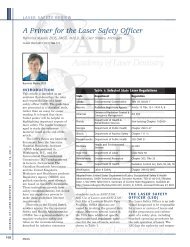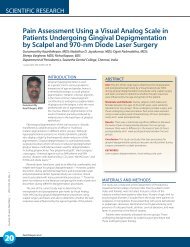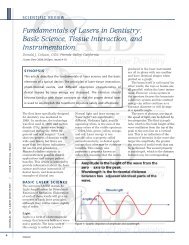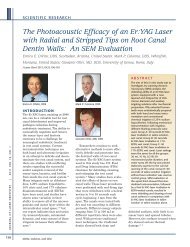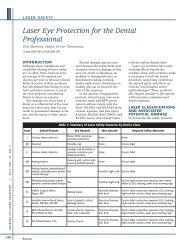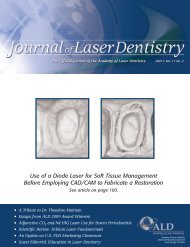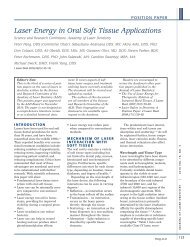You also want an ePaper? Increase the reach of your titles
YUMPU automatically turns print PDFs into web optimized ePapers that Google loves.
and thus can be effectively utilized<br />
for both surgery and debridement<br />
<strong>of</strong> the infected implant area.<br />
• The laser can make crestal,<br />
intrasulcular, or vertical release<br />
incisions in raising a flap. The<br />
Er:YAG laser produces a wet<br />
incision (some bleeding) as<br />
opposed to the dry incision (no<br />
bleeding) produced by other s<strong>of</strong>t<br />
tissue lasers. 15<br />
• The laser easily vaporizes any<br />
existing granulation tissue, with<br />
a lower risk <strong>of</strong> overheating the<br />
bone than those posed by the<br />
current diode or CO2 lasers. 16-17<br />
The Er:YAG laser wavelength’s<br />
excellent ability to effectively<br />
ablate s<strong>of</strong>t tissue without<br />
producing major thermal sideeffects<br />
to adjacent tissue has<br />
been demonstrated in numerous<br />
studies. 18-20<br />
• The implant surface can be<br />
debrided by lasing directly on the<br />
implant’s exposed screws with a<br />
low-energy setting. Both the<br />
target tissue and implant surface<br />
are disinfected without damage. 21-25<br />
• Ablating the bone with the<br />
Er:YAG laser also ablates<br />
necrotic bone, as well as contours<br />
and reshapes the surrounding<br />
osseous tissue. 26-28<br />
• The laser is bactericidal. 29-30<br />
C A S E S T U DY<br />
This case describes treatment <strong>of</strong><br />
peri-implantitis with an Er:YAG<br />
laser.<br />
P R E T R E AT M E N T<br />
A. Outline <strong>of</strong> Case<br />
1. Clinical Examination<br />
A 51-year old male presented with<br />
no medical abnormalities. The<br />
patient presented by referral four<br />
months after having implants<br />
inserted in the location <strong>of</strong> the lower<br />
left and right lateral incisors.<br />
2. S<strong>of</strong>t- and Hard-Tissue<br />
Examination<br />
Periodontal probing showed generalized<br />
4 mm pockets with bleeding.<br />
The patient had very ineffective<br />
Figure 1: Patient condition upon presentation.<br />
Note the buccal fistula from the<br />
implant at tooth #25<br />
Figure 2: A periodontal probe inserted<br />
into the fistula<br />
oral hygiene, and does not brush or<br />
floss at all; consequently, all teeth<br />
were covered with plaque. Both <strong>of</strong><br />
the implants were nonsubmerged<br />
with abutments present. The lower<br />
right implant presented a labial<br />
fistula, the probing <strong>of</strong> which led to<br />
the apical end <strong>of</strong> the implant<br />
(Figures 1 and 2). The left implant<br />
presented without complications.<br />
The remaining s<strong>of</strong>t tissue was<br />
within normal limits.<br />
3. Radiographic Examination<br />
Panoramic and periapical X-rays<br />
showed a large radiolucency area<br />
surrounding about 70% <strong>of</strong> the right<br />
implant, implying massive bone<br />
loss (Figure 3).<br />
4. Mobility Tests<br />
The infected implant was stable<br />
with no mobility.<br />
B. Diagnosis and Treatment Plan<br />
1. Provisional and Final Diagnosis<br />
Advanced peri-implantitis with<br />
massive bone loss around the<br />
implant.<br />
C A S E R E P O R T<br />
Figure 3: X-ray image with gutta-percha<br />
inside the fistula, pointing into the defect<br />
Figure 4: The Er:YAG handpiece with the<br />
200-micron sapphire tip ready for the<br />
incision<br />
2. Treatment Plan<br />
An Er:YAG laser will be used for<br />
flap incision, ablation <strong>of</strong> granulation<br />
tissue around the implant,<br />
remodeling, shaping and decortication<br />
<strong>of</strong> the bone, debridement <strong>of</strong><br />
exposed implant screw and guided<br />
bone regeneration (GBR) technique<br />
for the bone loss.<br />
3. Treatments Alternatives<br />
Traditional scalpel, curettes, citric<br />
acid, air flow, air abrasion, and<br />
rotary tools.<br />
T R E AT M E N T<br />
A. <strong>Laser</strong> Operating Parameters<br />
An intrasulcular incision was made<br />
with an Er:YAG laser (OpusDuo<br />
AquaLite, Lumenis Ltd.,<br />
Yokneam, Israel) (2940 nm), using<br />
Reyhanian and Coluzzi<br />
J O U R N A L O F L A S E R D E N T I S T R Y | 2 011 V O L . 19 , N O . 3<br />
277





